

Axolotl
(Ambystoma mexicanum)
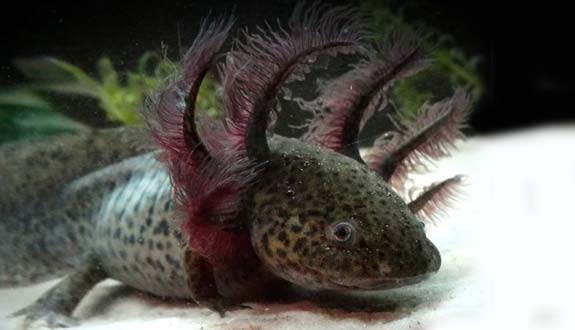
Thanks to Emi Lie and Axolotl-Passion
Alternative species (click on the thumbnail to see the card)
Names
Scientific name
Ambystoma Mexicanum
Gyrinus mexicanus
Common name
Axolotl
Mexican Walking Fish
Origin

Origin: Mexico
Biotope: not specified
Dimorphism

The female is «wider». The cloacal region of the male is swollen and long, the female’s flat and short
Group
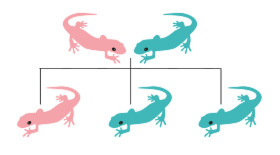
Ambystomatidae
Size

80 L / 17 imp gal / 21 US gal
100x40x40 cm or 39x16x16" (Lxlxh)
Parameters

T°: 14 to 20°C or 57 to 68°F
pH: 7 to 8.5
Hardness: 6 to 17°dGH
Difficulty

Average
Size

15 to 35 cm (6 to 12")
Longevity

15 to 20 years
Living zone
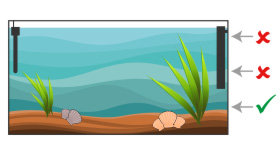
Depth
Individuals

1
Food
How to feed the Axolotl?
Food
How to feed the Axolotl?
Axolotl is a carnivore. There are foods specifically dedicated to Axolotls that will make a good basic diet. To vary their meals, you can also offer them earthworms, bloodworms, pike pieces, perch or trout. The heart of beef can also be proposed as a treat.
On the other hand, never give them food containing iodine.
Behavior
What kind of behavior does the Axolotl have?
Behavior
What kind of behavior does the Axolotl have?
It is a rather nocturnal animal. Moreover, you will observe increased activity at sunrise and sunset.
It lives mainly at the bottom of the tank. Besides, it walks more than it swims. If an Axolotl stays constantly near the surface, it is a sign of distress. Check its state of stress, if it is sick, and check the water parameters.
Note that it is very sensitive to stress.
Cohabitation
Who can live with the Axolotl?
Cohabitation
Who can live with the Axolotl?

A specific aquarium is highly recommended.
It is naturally lonely, and will not suffer from being alone. However, the company of its congeners is a plus. In this case, plan an aquarium of at least 120 liters (26 imp gal / 32 US gal) for 2 individuals because they are quite territorial.
To put it simply, it is better to avoid cohabitation with fish. In fact, small fish are used as meals, and the larger ones may want to «eat» the gills of the Axolotls (because of their resemblance to mudsworms), which could then see the onset of repeated infections. Even snails pose a danger because Axolotls could swallow and choke (except the Pomacea that could work if the aquarium is big enough).
Some still maintain Axolotls with Guppy, Cardinal Fish, Gambusia, Danio rerio or Platys. Be aware however that some will disappear from time to time!
The best cohabitation is undoubtedly the one with its congeners. However, be careful with their size difference between individuals, which should not exceed 5 cm (2 inches).
It is not aggressive, but because of its poor eyesight, it can happen that it nibbles the paw or the gills of its congeners. This remains relatively minor, since the injured will push the missing part over time.
Breeding
How to breed the Axolotl?
Breeding
How to breed the Axolotl?
Pretty easy and does not necessarily require the intervention of the aquarist.
The Axolotl are sexually mature from a year or when they reach about twenty centimeters. The colour of the fingertips changes then: it goes from light to dark or from dark to clear. Before this age, it is difficult to differentiate between the sexes. In general, the female is «wider» than the male. The cloacal region of the male is inflated and long, while that of the female is flat and short.

Female axolotls

Male Axolotls
Thanks to Amandine for these photos
If your Axolotls have trouble reproducing, lower the temperature around 10/15 °C (50 to 60 °F) to stimulate spawning.
The breeding season lasts from the end of fall until spring. When the female is ready for breeding, it emits an odor that the male recognizes. After the love parade, the male deposits spermatophores (a kind of jelly containing spermatozoa). The female then comes to rest on this jelly and the fertilization takes place directly in its belly. Spawning can start from 1 to 3 days after these events.Spawning can range from 100 to 1500 eggs, with an average of 300. Incubation lasts about 14 days.
Young fish will be adults at the age of 18/24 months.
Youth food: Artemia nauplii.
Note that females produce eggs even without the presence of a male. However, it will be beneficial for them to meet a male from time to time to expel their eggs.
If you do not want to farm, remove the eggs from the aquarium.
Its aquarium
Which aquarium for the Axolotl?
Its aquarium
Which aquarium for the Axolotl?
The ideal form of aquarium will be the one that will offer the most space on the ground: plan at least 1 meter long by 40 cm wide (39 by 16 inches). The height of water will be at least 40 cm (16 inches).
Ideal water parameters: temperature at 17/18 °C (62/64 F), pH at 7.5/8, GH at 11/12 °dGH. Note that given the temperature, heating is completely useless. On the other hand, it might be necessary to invest in a cold group.
Avoid gravel, glass balls, pebbles because this batrachian could swallow it inadvertently and this could cause serious health problems (this problem is quite common!). Choose a very fine sand (2 mm, and up to 4 mm for individuals over 20 cm (8 inches)) and not sharp, if possible dark or natural colour. Spread a layer of 5 cm (2 inches) at the bottom of the tank. Never put nutrient soil underneath as it is toxic to Axolotls.
For decoration, avoid overly projecting roots or sharp rocks because Axolotls often injure themselves.
Axolotls in captivity are subject to stress. To reduce it, it is necessary to respect certain fundamentals:
First of all, they do not like the current and prefer stagnant water. However, they are big polluters. It will therefore be necessary to provide a powerful filtration (between 3 and 5 times the volume of the aquarium per hour) which will ensure a good mixing and good water quality. On the other hand, make sure that the current is mainly directed towards the top of the aquarium. Thus, the current will be limited in their area of life (at the bottom of the aquarium). Do not hesitate to «break» the current at the exit of the pump against one of the walls of the tank, or to use a pierced cane... To keep a good quality of water, complete with many plants and make large and regular water changes (20% minimum each week). Feel free to siphon the bottom of the tank on this occasion to clean it. The water used can be that of the tap, that you will let rest 24 to 48 hours to allow the evaporation of the chlorine.

For decoration, try to «hide» them (the fish of course)! They will feel safer if they have a fallback solution available!
Lighting is not mandatory (nocturnal animal). If you are installing a lighting system (necessary for plants if your bin is closed for example), sift a lot with floating plants.
It is best to leave the aquarium open: this will allow better ventilation, the water will remain «cold» and the plants will have brightness!
On the plant side, choose plants that can live in rather cold water and not too demanding in lighting. For this, opt for Anubias, Lemna minor, Ceratophyllum demersum, Cryptocoryne, Vesicularia, Echinodorus, Groenlandia densa, Microsorum pteropus, Java moss, Java fern. Since the bin is open, you can also choose semi-submerged plants, such as Chlorophytum for example.
The roots are to be avoided because the tannin which they release can be toxic for the Axolotls (opt for their alternative in resin!).
Good To know
Find all additional information!
Good To know
Find all additional information!
Its name «Axolotl» comes from a word of Aztec origin that means «water dog».
It can spend all its life and breed in the larval state without ever going to adult stage! In fact, in aquarium, it lives completely immersed and thus promotes the development of its gills (juvenile organs). This ability is called «neoteny».
Originally, axolotl is able to metamorphose from the larval stage to the adult salamander. Unfortunately, the majority of commercially sold specimens have lost this ability. It seems that genetics is the determining factor triggering this metamorphosis. It can also be obtained in the laboratory by injection. For axolotls kept in captivity, they will remain aquatic all their life!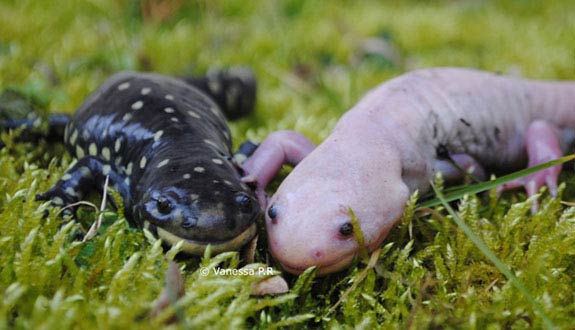
The Axolotl has the incredible ability to reconstruct damaged parts of the body: paw, tail, eye, and even part of the brain!
Unfortunately, it is critically endangered in its natural environment. Normally, all the animals sold in the trade are therefore from breeding.
It sometimes goes into «ghost» mode. It then becomes very pale, completely white (even the gills). This may be due to intense rest (only during the day) or poor water parameters.
Handle your Axolotl only in case of extreme necessity! Indeed, it stresses very quickly and manipulations are to be avoided as much as possible.
The base colour is dark, ranging from almost black (melanoid), to brown and gray. There are colour variants of this species:
Base colour (to brown and gray)

Black (melanoid)
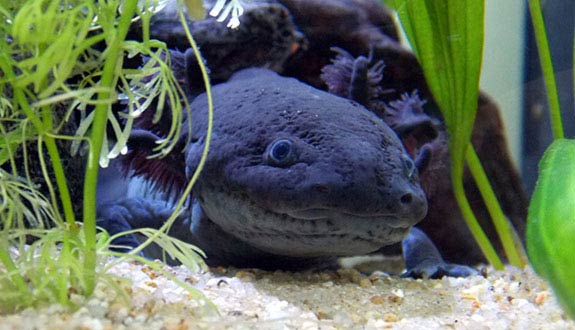
White albino
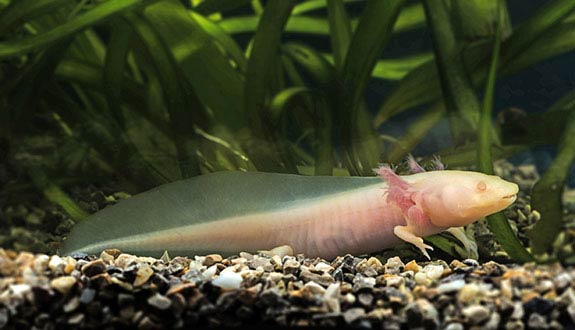
Golden albino

Leucitic (white with black eyes)

Harlequin (spotted)
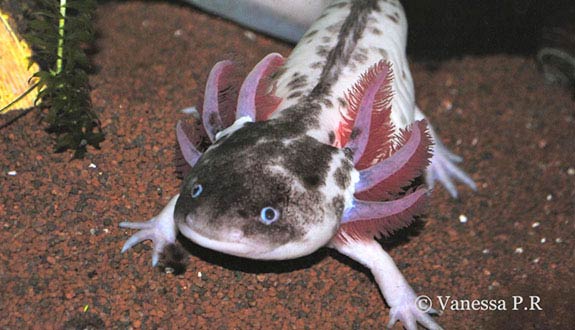
Copper (yellow speckled)
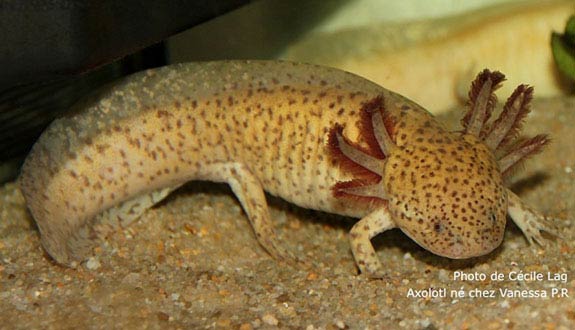
Chimera (fusion of 2 embryos)

For more information / Source: Axolotl Passion (http://www.axolotl-passion.net/)
Yours photos!

By Encyclo-Caro

By Encyclo-Caro

By Encyclo-Caro
Comments
Sort by:
Please login to post comments
